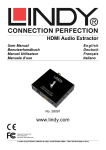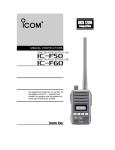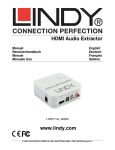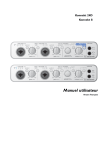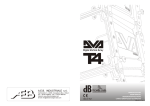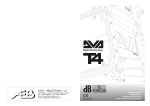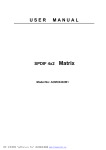Download LINDY User Manual
Transcript
HDMI 4K Audio Extractor User Manual Benutzerhandbuch Manuel Utilisateur Manuale d’uso Eng li sh Deutsch Français Italiano No. 38097 www.lindy.com Tested to Comply with FCC Standards For Home and Office Use! © LINDY ELECTRONICS LIMITED & LINDY-ELEKTRONIK GMBH - FIRST EDITION (August 2014) User Manual English Introduction Thank you for purchasing the LINDY HDMI 4K Audio Extractor with MHL and ARC support. This device allows you to extract audio from your HDMI or MHL signal while sending the video signal to your HD display or projector. The extracted audio can be sent to an AV receiver or speakers in analogue* and digital audio formats, allowing you to enjoy superior sound delivery. In addition ARC signals received from a connected display can also be output to an AV Receiver using the TOSLink output. *PCM HDMI audio in only, not Dolby Digital, DTS or ARC Mode Package Contents HDMI 4K Audio Extractor Multi-Country 5V 1.2A Power Supply (US,UK, EU & AUS) This manual Features Extracts stereo or multi-channel audio from HDMI and MHL signals Extracts ARC stereo or multi-channel audio from HDMI ARC signals HDMI audio pass-through allows audio to be sent to a HDMI display Specification HDMI 1.4 and HDCP 1.4 compliant Supports HDTV resolutions: 480i, 576i, 480p, 576p, 720p, 1080i, 1080p & 4K 3840x2160p30 Supports MHL 2.0 inputs from Smartphones and Tablets at up to 1080p60 3D signal support, including 1080p24 and 720p50/60 Supports HDMI audio sample rates up to 24bit 192KHz Digital audio supports: PCM2, Dolby 5.1, DTS 5.1 Analogue audio supports: LPCM2, LPCM 5.1 Input: HDMI A (Supports HDMI and MHL signals) Output: HDMI A, Phono audio and TOSLink Optical Input Format PCM 2, 5.1 or 7.1 Channel Dolby Digital / DTS 2 Channel HDMI ARC Output via Phono TOSLink Yes Yes No Yes No Yes User Manual English Installation and operation The following graphic shows the Audio Extractor connected in a typical set up, with HDMI/MHL cables connected between the source equipment, Audio Extractor and HDMI display equipment. Additionally a cable is connected between one or more of the Extractor’s audio outputs and an AV receiver/amplifier. HDMI Cable MHL Cable TOSLink / Phono Cable or or Installation is simple, make sure that all devices are powered off and then connect the cables as described above and then connect the provided power supply and power on all devices. The Power LED will illuminate red when the power supply is connected, whilst the Status LED will only illuminate green when a HDMI signal is received. Once playback commences sound is output through all of the audio out interfaces simultaneously. By default the extractor is set to advanced mode, this allows either multi-channel or stereo audio to be input/output via the extractor. By pressing the Select button you can change this setting to stereo or multi-channel only, this will affect the EDID data that is shown to your HDMI source device and so the screen may flash on/off briefly whilst handshaking occurs. For installations using multiple HDMI sources, position the Audio Extractor between a HDMI switch and HDMI display equipment. Installations using multiple HDMI displays require the Audio Extractor to be positioned before a HDMI splitter. ARC Mode The Audio Extractor can also be used to send audio from a DVB-T or DVB-S signal from your TV’s internal tuner to your AV Receiver via an ARC enabled HDMI port. To use the Audio Extractor in ARC Mode, make sure that the Extractor is connected to a HDMI port on your HDMI TV which supports the ARC function and that a TOSLINK cable is connected between the Extractor and your AV Receiver. Press the ARC Select button on the front of the Extractor, the ARC LED will then illuminate green and the audio signal will be sent to your AV Receiver. To switch back to standard mode press the ARC Select button again, the ARC LED will then switch off and the Extractor is now set back to Standard mode. Benutzerhandbuch Deutsch Einführung Dieser LINDY HDMI 4K Audio Extractor mit MHL und ARC Unterstützung erlaubt Ihnen sowohl digitale wie auch analoge Audiosignale aus einem HDMI oder MHL Signal zu extrahieren und das ursprüngliche Signal ebenfalls weiterzuleiten. Darüber hinaus kann er Audio auch aus dem HDMI ARC Signal von einem HDMI Display/TV/Projektor extrahieren. Die Audioausgabe erfolgt digital über TosLink und analog über Stereo RCA, letzteres nicht bei Extraktion aus dem ARC Signal. Dies ist zum Beispiel sehr nützlich wenn Ihr HDMI Monitor nicht über eingebaute Lautsprecher oder Audioausgänge verfügt oder wenn Ihre HDMI Quelle keine analogen Audioausgänge hat. Lieferumfang HDMI 4K & MHL Audio Extractor 5VDC ca. 1,2A Multi-Country Netzteil (mit Adaptersteckern für US,UK, EU & AUS/CN) Dies Handbuch Eigenschaften Extrahiert Stereo oder Multi-Channel Audio aus einem HDMI oder MHL Signal Extrahiert Multi-Channel Audio aus einem ARC Signal, Ausgabe nur über Toslink Audioausgabeformat abhängig vom Audioeingangssignal, siehe Tabelle HDMI Bypass (mit Audio) Audio-Eingangsformat Unkomprimiert, PCM 2, 5.1/7.1 Kanal Dolby Digital / DTS 2 Kanal HDMI ARC Signal Audioausgabe RCA Buchsen Toslink Buchse Ja Ja Nein Ja Nein Ja Spezifikation HDMI 1.4 und HDCP kompatibel Unterstützt folgende HDTV Auflösungen: 480i/p, 576i/p, 720p, 1080i/p und 4K 3840x2160p30 Unterstützt MHL 2.0 Eingangssignale von Smartphones, Tablets, etc. bis 1080p60 3D kompatibel, inklusive 1080p24 und 720p50/60 Unterstützt HDMI Audio Sampling-Raten bis 24bit 192KHz Digital Audio unterstützt PCM2, Dolby 5.1, DTS 5.1 Analog Audio unterstützt: LPCM2 & LPCM 5.1 Eingang: HDMI Typ A Buchse (unterstützt HDMI und MHL) Ausgänge: HDMI Typ A Buchse, Toslink optisch (digital) und RCA Stereo (analog) Benutzerhandbuch Deutsch Installation und Betrieb Die folgende Grafik zeigt den Audio Extractor in einem typischen Aufbau, Durchgezogenen roten Linien stellen die HDMI Kabelverbindungen dar, die grün gestrichelte Linie die Audioverbindung zum Beispiel zu einem AV Receiver/Verstärker, die blau gestrichelte eine MHL Verbindung. HDMI Kabel MHL Kabel Toslink oder RCA Audio Kabel or or Die Installation ist einfach, schließen Sie einfach nur die Kabel und dann Stromversorgung an. Die POWER LED am Extractor leuchtet rot bei bestehender Stromversorgung. Die Status LED leuchtet grün wenn ein HDMI Signal anliegt und erkannt wird. Audio wird dann umgehend ausgegeben. Per Voreinstellung ist der Extractor auf den erweiterten „Advanced“ Audiomodus eingestellt, dies erlaubt entweder die Multi-Kanal oder Stereo Ein- und Ausgabe. Durch Drücken der SELECT Taste kann der Modus auf Nur-Stereo oder Nur-Multi-Kanal-Audio eingestellt werden; dies verändert die EDID Daten, die der Extraktor an die HDMI-Signalquelle liefert, so dass diese sich darauf neu einstellt und eventuell kurz das HDMI-Signal unterbricht – auch das Display schaltet dann kurz dunkel und synchronisiert neu. In Installationen mit mehreren HDMI Signalquellen platzieren Sie den Extraktor direkt zwischen Display und Umschalter. In Installationen mit mehreren HDMI Displays platzieren Sie den Extraktor direkt zwischen der HDMI Signalquelle und dem Splitter oder Umschalter. ARC Modus Der Audio-Extraktor kann auch für ARC Signale genutzt werden, z.B. wenn interne DVB-T, DVB-C oder DVB-S Receiver im TV eingebaut sind und der TV über einen HDMI ARC Port verfügt. Um den ARC Modus zu verwenden muss der Extraktor an einem HDMI ARC Port angeschlossen werden. Schließen Sie Ihre Soundanlage/Audiogeräte über Toslink Kabel an den Extraktor an. Drücken Sie die ARC SELECT Taste am Extraktor, die ARC LED sollte dann grün leuchten und das Signal sollte via Toslink ausgegeben werden. Durch erneutes Drücken der ARC SELECT Taste wird der Standardmodus wieder hergestellt. Manuel Utilisateur Français Introduction Merci d’avoir choisi l’ extracteur audio HDMI 4K LINDY, avec prise en charge MHL et ARC. Cet appareil vous permettra d’extraire l’audio d’un signal HDMI ou MHL pendant la transmission du signal vidéo sur votre écran ou projecteur HD. Le signal audio extrait peut être transmis à un récepteur audio/vidéo ou haut-parleur au format analogique* ou numérique, vous permettant de profiter d’un son d’une qualité supérieure. De plus, les signaux ARC provenant d’un affichage connecté, peuvent également être passés sur un récepteur audio/vidéo en utilisant la sortie TOSLink. *PCM HDMI audio en entrée uniquement, pas en mode Dolby Digital, DTS ou ARC Contenu de l’emballage Extracteur audio HDMI 4K Alimentation mullti-pays 5V 1.2A (US,UK, EU & AUS) Ce manuel Caractéristiques Extrait l’audio stéréo ou multi-canaux à partir de signaux HDMI et MHL Extrait les signaux audio stéréo ou multi-canaux ARC à partir des signaux HDMI ARC HDMI audio pass-through permettant à l’audio d’être transmis à un écran HDMI Spécifications Compatible HDMI 1.4 et HDCP 1.4 Prise en charge des résolutions HDTV: 480i, 576i, 480p, 576p, 720p, 1080i et 1080p Prend en charge les entrées MHL 2.0 de Smartphones et Tablettes jusqu’au 1080p60 Prend en charge les signaux 3D, 1080p24 et 720p50/60 inclus Prise en charge de l’audio HDMI avec taux d’échantillonnage jusqu’au 24bit 192KHz Prise en charge de l’audio numérique: PCM2, Dolby 5.1, DTS 5.1 Prise en charge de l’audio analogique: LPCM2, LPCM 5.1 Entrée: HDMI A (prend en charge les signaux HDMI et MHL) Sorties: HDMI A, RCA audio, TosLink Optique Format d’entrée PCM 2, 5.1 ou 7.1 Channel Dolby Digital / DTS 2 Channel HDMI ARC Sortie via RCA / Phono TOSLink Oui Oui Non Oui Non Oui Manuel Utilisateur Français Installation et utilisation Le schéma suivant montre l’extracteur audio branché dans une configuration typique, avec les câbles HDMI/MHL connectés entre l’équipement source, l’extracteur audio et un écran HDMI. Additionnelement, un câble est branché entre une ou plusieurs sorties audio de l’extracteur audio et un récepteur/amplificateur audio/vidéo. Câble HDMI Câble MHL Câble TOSLink / RCA audio ou ou L’Installation est simple, assurez vous que tous les appareils sont hors tension et branchez ensuite les câbles comme décrit, connectez ensuite l’alimentation fournie et mettez tous les appreils sous tension. La LED d’alimentation sera rouge lors de l’alimentation du boitier, tandis que le voyant d’état ne s’allume en vert que lorsqu’un signal HDMI est reçu. Une fois la lecture commencée le son sera émis sur toutes les interfaces de sortie audio simultanément. Par défaut l’extracteur est réglé sur le mode avancé “advanced mode”, celà permet au son multichannel ou stéréo d’être entré/sortie via l’extracteur. En appuyant sur le bouton de sélection (Select), vous pourrez positionner ce réglage sur stéréo ou multi-canaux uniquement, celà affectera les données EDID qui sont transmises à votre source HDMI et l’affichage de votre écran clignotera brièvement pendant ma mise à jour des données. Pour l’installation en multi-sources HDMI, placez l’extracteur audio entre un switch HDMI et votre écran HDMI. Les installations multi-écrans HDMI nécéssiteront que le positionnement de l’extracteur audio soit fait avant un splitter HDMI. Mode ARC L’extracteur audio peut aussi être utilisé pour transmettre l’audio d’un signal DVB-T ou DVB-S du tuner interne de votre TV vers votre récepteur AV via un port HDMI équipé de la fonction ARC. Pour utiliser l’extracteur audio en mode ARC, assurez-vous que l’extracteur est connecté à un port HDMI de votre TV HDMI prenant en charge la fonction ARC et qu’un câble TOSLINK est connecté entre l’ extracteur et votre récepteur AV. Pressez le bouton ARC sur le devant de l’extracteur, la LED ARC s’allumera ensuite en vert et le signal audio sera envoyé à votre récepteur AV. Pour revenir au mode standard, appuyez encore une fois sur le bouton ARC, la LED ARC s’éteindra et l’extracteur sera à nouveau en mode standard. Manuale d’uso Italiano Introduzione Grazie per aver acquistato l’Audio Extractor HDMI 4K LINDY con supporto MHL e ARC. Questo dispositivo vi consentirà di estrarre il segnale audio da una connessione HDMI o MHL ed inviarlo ad un amplificatore AV o ad un sistema di altoparlanti sia in formato digitale che analogico* permettendovi di fruire di un suono di qualità superiore. In aggiunta il segnale ARC ricevuto da un display connesso in uscita può essere inviato ad un amplificatore AV utilizzando la porta Toslink. * Solo con segnale sorgente HDMI Audio in formato PCM (Non supporta Dolby Digital, DTS o modalità ARC) Contenuto della confezione Audio Extractor HDMI 4K Alimentatore Multi-Country 5V 1,2A (US,UK, EU & AUS) Alette di montaggio con viti Questo manuale Caratteristiche Estrae il segnale audio stereo o multi-canale da quello HDMI e MHL Estrea segnali ARC audio stereo o multicanale da una connessione HDMI ARC La funzione HDMI audio pass-through permette di trasmettere comunque la sezione audio anche al televisore Specifiche Conforme HDMI 1.4 e HDCP 1.4 Supporta risoluzioni HDTV 480i, 576i, 480p, 576p, 720p, 1080i e 1080p & 4K 3840x2160p30 Supporta segnali MHL 2.0 in ingresso da Smartphone e Tablet fino a 1080p60 Supporta segnali 3D inclusi 1080p24 e 720p50/60 Supporta segnali HDMI audio fino a 24bit 192KHz Formati Audio Digitali supportati: PCM2, Dolby 5.1, DTS 5.1 Formato Audio Analogico supportato: LPCM2, LPCM 5.1 Ingresso: HDMI A (Supporta segnali HDMI e MHL) Uscite: HDMI A, Audio stereo RCA ed Ottico TOSLink Uscita attiva Formato in ingresso PCM 2, 5.1 or 7.1 Canali Dolby Digital / DTS 2 Canali HDMI ARC RCA Stereo Si No No TOSLink Si Si Si Manuale d’uso Italiano Installazione ed Uso Il seguente diagramma mostra un’installazione tipica dell’HDMI Audio Extractor con le sorgenti connesse tramite un cavo HDMI/MHL all’audio extractor che a sua volta è connesso tramite un altro cavo HDMI al televisore. In aggiunta un cavo audio (ottico, coassialle o stereo) connette il dispositivo ad un amplififcatore AV. Cavo HDMI Cavo MHL Cavo TOSLink / Phono o o L’installazione è semplice ma quando la effettuate controllate che tutti i dispositivi siano spenti. Collegate tutti i cavi come indicato sopra, collegate l’alimentarore fornito in dotazione e poi accendetne tutti i dispositivi. Il LED Power si illuminerà in rosso non appena l’alimentatore verrà collegato ad una presa di corrente mentre il LED Status si illuminerà di verde non appena verrà rilevato un segnale HDMI in ingresso. Non appena inizierà la riproduzione dei contenuti il flusso audio verrà inviato a tutte le uscite contermporaneamente. Di base l’extractor è impostato in modalità “avanzata”; in questo modo il dispositivo tratterà correttamente sia segnali multicanale che stereo. Premendo il pulsante Select potrete passare alla modalità solo Stereo o a quella solo Multicanale. Questa operazione influisce sui dati EDID trasmessi e ciò può comportare dei brevi flash dello schermo che dovrà effettuare nuovamente la negoziazione della modalità operativa con la sorgente. Il LED Selezione Canali si spegnerà indicando il funzionamento nella sola modalità stereo. Quando utilizzate l’uscita audio stereo jack da 3.5mm usate un cavo audio stereo 3.5mm a 3.5mm o uno da 3.5mm a phono (RCA) in base alle porte presenti sull’amplificatore. Per installazioni che utlizzano più sorgenti HDMI, posizionate l’Audio Extractor fra lo switch HDMI e lo schermo. In caso vogliate invece inserire il dispositivo in installazioni con più schermi posizionate l’extractor prima dello splitter HDMI. Modalità ARC L’Audio Extractor può essere anche utilizzato per mandare il segnale audio proveniente dai sintonizzatori DVB-T o DVB-S integrati nei televisori ad un amplificatore AV esterno tramite una porta HDMI con funzionalità ARC. Per usare l’ Audio Extractor in modalità ARC solo se connesso ad una porta HDMI del vostro televisore dotata di funzionalità ARC e se il vostro amplififcatore AV è provvisto di un ingresso TOSLink ottico da connettere all’Extractor con un cavo ottico TOSLink. Premete il tasto ARC Select sul pannello frontale dell’extractor e il LED ARC si illuminerà in verde indicando che il segnale audio verrà da quel momento inviato alla porta Toslink. Per ritornare alla modalità standard premete ancora il tasto ARC Select, il LED ARC si spegnerà e il dispositivo ritornerà in modalità Standard. CE/FCC Statement CE Certification This equipment complies with the requirements relating to Electromagnetic Compatibility Standards EN55022/EN55024 and the further standards cited therein. It must be used with shielded cables only. It has been manufactured under the scope of RoHS compliance. CE Konformitätserklärung Dieses Produkt entspricht den einschlägigen EMV Richtlinien der EU für IT-Equipment und darf nur zusammen mit abgeschirmten Kabeln verwendet werden. Diese Geräte wurden unter Berücksichtigung der RoHS Vorgaben hergestellt. Die formelle Konformitätserklärung können wir Ihnen auf Anforderung zur Verfügung stellen FCC Certification This equipment has been tested and found to comply with the limits for a Class B digital device, pursuant to part 15 of the FCC Rules. These limits are designed to provide reasonable protection against harmful interference in a residential installation. You are cautioned that changes or modification not expressly approved by the party responsible for compliance could void your authority to operate the equipment. This device complies with part 15 of the FCC Rules. Operation is subject to the following two conditions: 1. This device may not cause harmful interference, and 2. This device must accept any interference received, including interference that may cause undesired operation. LINDY Herstellergarantie – Hinweis für Kunden in Deutschland LINDY gewährt für dieses Produkt über die gesetzliche Regelung in Deutschland hinaus eine zweijährige Herstellergarantie ab Kaufdatum. Die detaillierten Bedingungen dieser Garantie finden Sie auf der LINDY Website aufgelistet bei den AGBs. Recycling Information WEEE (Waste of Electrical and Electronic Equipment), Recycling of Electronic Products Europe, United Kingdom In 2006 the European Union introduced regulations (WEEE) for the collection and recycling of all waste electrical and electronic equipment. It is no longer allowable to simply throw away electrical and electronic equipment. Instead, these products must enter the recycling process. Each individual EU member state has implemented the WEEE regulations into national law in slightly different ways. Please follow your national law when you want to dispose of any electrical or electronic products. More details can be obtained from your national WEEE recycling agency. Germany / Deutschland Die Europäische Union hat mit der WEEE Direktive Regelungen für die Verschrottung und das Recycling von Elektro- und Elektronikprodukten geschaffen. Diese wurden im Elektro- und Elektronikgerätegesetz – ElektroG in deutsches Recht umgesetzt. Dieses Gesetz verbietet das Entsorgen von entsprechenden, auch alten, Elektro- und Elektronikgeräten über die Hausmülltonne! Diese Geräte müssen den lokalen Sammelsystemen bzw. örtlichen Sammelstellen zugeführt werden! Dort werden sie kostenlos entgegen genommen. Die Kosten für den weiteren Recyclingprozess übernimmt die Gesamtheit der Gerätehersteller. France En 2006, l'union Européenne a introduit la nouvelle réglementation (DEEE) pour le recyclage de tout équipement électrique et électronique. Chaque Etat membre de l’ Union Européenne a mis en application la nouvelle réglementation DEEE de manières légèrement différentes. Veuillez suivre le décret d’application correspondant à l’élimination des déchets électriques ou électroniques de votre pays. Italy Nel 2006 l’unione europea ha introdotto regolamentazioni (WEEE) per la raccolta e il riciclo di apparecchi elettrici ed elettronici. Non è più consentito semplicemente gettare queste apparecchiature, devono essere riciclate. Ogni stato membro dell’ EU ha tramutato le direttive WEEE in leggi statali in varie misure. Fare riferimento alle leggi del proprio Stato quando si dispone di un apparecchio elettrico o elettronico. Per ulteriori dettagli fare riferimento alla direttiva WEEE sul riciclaggio del proprio Stato. LINDY No 38097 1st Edition, August 2014 www.lindy.com Tested to Comply with FCC Standards For Home and Office Use!












